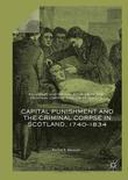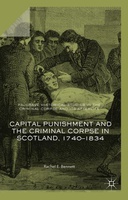Explore

Capital Punishment and the Criminal Corpse in Scotland, 1740–1834
Rachel E. Bennett
2018
This book provides the most in-depth study of capital punishment in Scotland between the mid-eighteenth and early nineteenth century to date. Based upon an extensive gathering and analysis of previously untapped resources, it takes the reader on a journey from the courtrooms of Scotland to the theatre of the gallows. It introduces them to several of the malefactors who faced the hangman’s noose and explores the traditional hallmarks of the spectacle of the scaffold. It demonstrates that the period between 1740 and 1834 was one of discussion, debate and fundamental change in the use of the death sentence and how it was staged in practice. In addition, the study provides an innovative investigation of the post-mortem punishment of the criminal corpse. It offers the reader an insight into the scene at the foot of the gibbets from which criminal bodies were displayed, and around the dissection tables of Scotland’s main universities where criminal bodies were used as cadavers for anatomical demonstration. In doing so it reveals an intermediate stage in the long-term disappearance of public bodily punishment.
This book is included in DOAB.
Why read this book? Have your say.
You must be logged in to comment.
Rights Information
Are you the author or publisher of this work? If so, you can claim it as yours by registering as an Unglue.it rights holder.Downloads
- 104 - pdf (CC BY) at OAPEN Library.
- 213 - mobi (CC BY) at Unglue.it.
- 134 - pdf (CC BY) at Unglue.it.
- 194 - epub (CC BY) at Unglue.it.
Keywords
- Autopsy
- Capital punishment
- criminal corpse
- Dissection
- Edinburgh
- Eighteenth century
- England
- Gallows
- Gibbeting
- Glasgow
- History
- history of crime
- Humanities
- medical humanities
- nineteenth century
- Scotland
- Scottish history
- thema EDItEUR::N History and Archaeology::NH History
Links
DOI: 10.1007/978-3-319-62018-3web: https://link.springer.com/book/10.1007/978-3-319-62018-3
Editions


